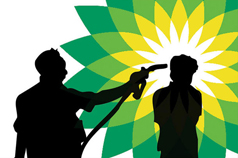Long After Spill, BP Gets 'F' Ratings for Alaska Pipelines
 Is there another BP disaster waiting to happen, this time in Alaska?
Is there another BP disaster waiting to happen, this time in Alaska? The British oil giant has had several major accidents in the United States over the last five years, in part because of inadequate attention to maintenance and safety.
Most famously, a BP deepwater well blew out in April, killing 11 rig workers and spilling millions of barrels of crude oil into the Gulf of Mexico. In 2005, an explosion at its Texas City, Tex., refinery left 15 dead and 170 others injured, and continuing problems at the facility led the government to impose a record $50.6 million fine on the company in August.
And in 2006, two huge oil spills occurred in Alaska because of corrosion in BP’s pipeline system.
According to a new report by the independent news organization ProPublica, BP’s pipeline network in Alaska is still at risk four years after the initial accident.
ProPublica obtained a four-week-old internal maintenance report that documented that at least 148 BP pipelines on the North Slope received an “F-rank” from the company itself because of corrosion that could potentially lead to ruptures and leaks of toxic and flammable substances.
A new rupture would not only potentially cause environmental harm, it would also deal BP another black eye as it struggles with the costs the gulf spill, which the company currently estimates at $40 billion. The last time there was a leak, the company had to shut down the entire pipeline network for repairs, idling 8 percent of domestic production.
According to ProPublica, BP employees have taken photographs showing sagging and rusted pipelines. According to one welder cited by the news organization, some of the pipes “have hundreds of patches on them.” And employees reportedly told ProPublica that several turbines designed to compress gas and push it through the pipelines “have been modified to run at higher stress levels and higher temperatures than they were originally designed to handle.”
BP responded to the allegations in a statement by Steve C. Rinehart, a BP spokesman in Alaska. Mr. Rinehart said that an “F” ranking does not imply that an accident is imminent. “It does prompt a higher priority repair plan depending on technical details and engineering review,” he said.
Mr. Rinehart said that since the 2006 Prudhoe Bay leaks, “we designed and installed a completely new system of oil transit lines,” which became operational in 2008. He added that the company now runs five times more “smart pig” operations for cleaning and inspecting pipelines, and the current 100,000 annual inspections for corrosion monitoring are about a third more than before the 2006 accident.
“This is all paying off,” Mr. Rinehart concluded. “We achieved a 42 percent reduction in corrosion/erosion-related leaks between 2006 and 2009.”
Source: New York Times
You can return to the main Market News page, or press the Back button on your browser.

